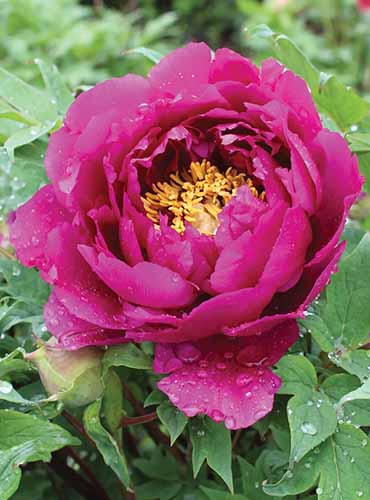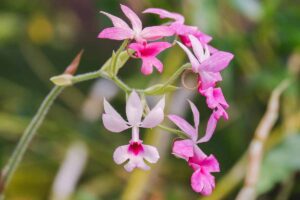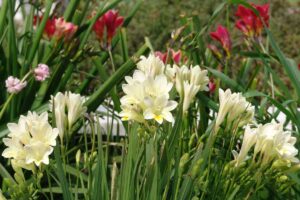Paeonia x rockii, P. x suffruticosa, Lutea Hybrids
I first learned about peonies as a garden plant years ago, and I’ve been a sucker for them ever since.
Herbaceous, woody, or intersectional – all that matters are those cheery spring blooms that spark joy in my heart.
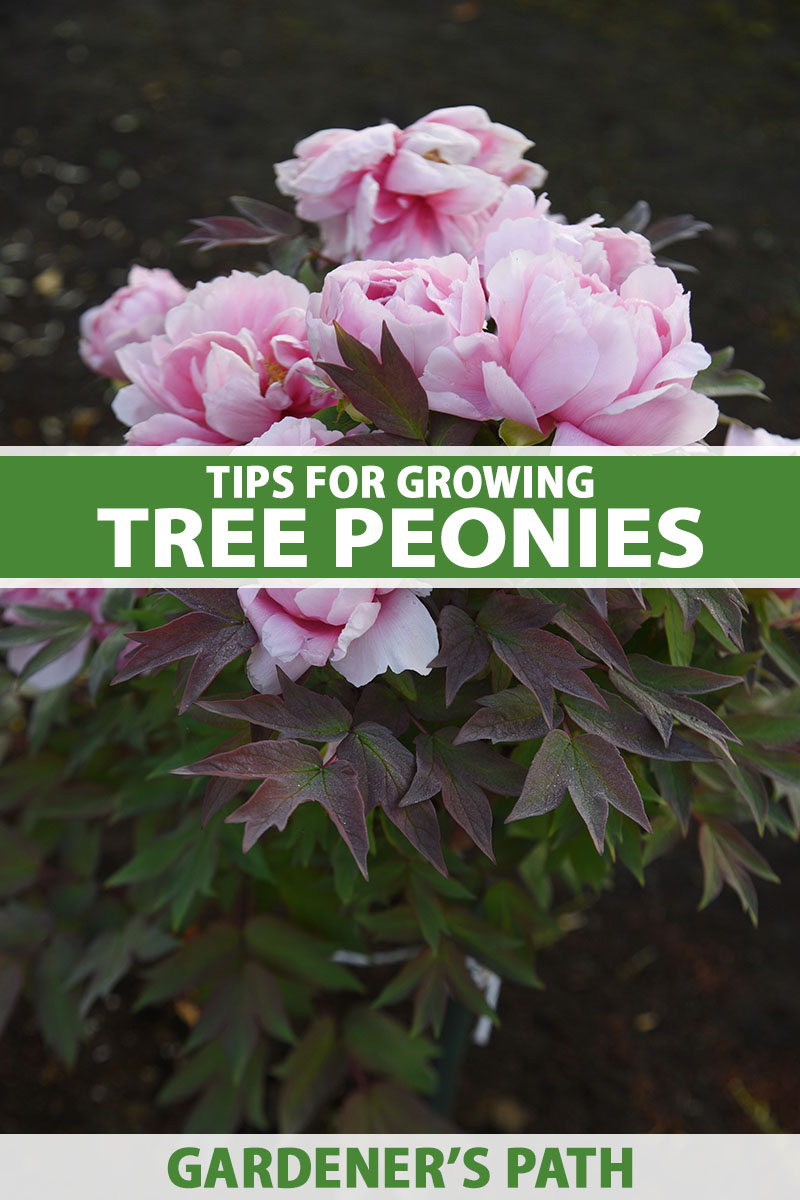
We link to vendors to help you find relevant products. If you buy from one of our links, we may earn a commission.
Tree peonies, also known as woody peonies, are slow-growing perennial shrubs with colorful single or double-petaled flowers.
Originally hybridized in China 1,500 years ago, they’ve been slowly making their way into gardens across the globe ever since.
There is a lot to cover! Here’s what’s ahead:
What You’ll Learn
Of all the tree peony hybrid groups, Japanese and Chinese Paeonia x suffruticosa has by far the most comprehensive range of flower colors, sizes, and types. This group is often used to create new hybrids for commercial sale.
The other hybrid groups considered to be tree peonies are P. x rockii and lutea hybrids. The care instructions for all types are generally the same, but we’ll get into that soon. Let’s dive in.
What Are Tree Peonies?
Tree peonies belong to the genus Paeonia, which includes both herbaceous and shrubby perennials grown for their unique, ornamental flowers.

Woody-stemmed peonies originated in China around 1,500 years ago. They are mainly derived from both P. x suffruticosa, the Chinese hybrids, and P. delavayi, also known as Delavay’s tree peony, a species native to China.
You may see many types of tree peonies referred to as their own species, P. suffruticosa instead of the hybrid designation P. x suffruticosa. There is much disagreement among growers and horticulturalists on how best to describe and classify these plants.
The American Peony Society even explains that referring to woody-stemmed types as tree peonies is incorrect, as they are technically shrubs.
The best way to understand these plants is to first have a grasp of the main hybrid groups. These groups are:
- Classic Japanese and Chinese peony, Moutan peony, or P. x suffruticosa
- Gansu, Rock’s peony, or P. x rockii
- Lutea hybrids, or P. delavayi x P. x suffruticosa
P. x suffruticosa is a group with the largest, and most diverse cultivars. The flowers in this group come in many different colors, from various shades of white, pink, and red, to maroon, purple, and bicolored.
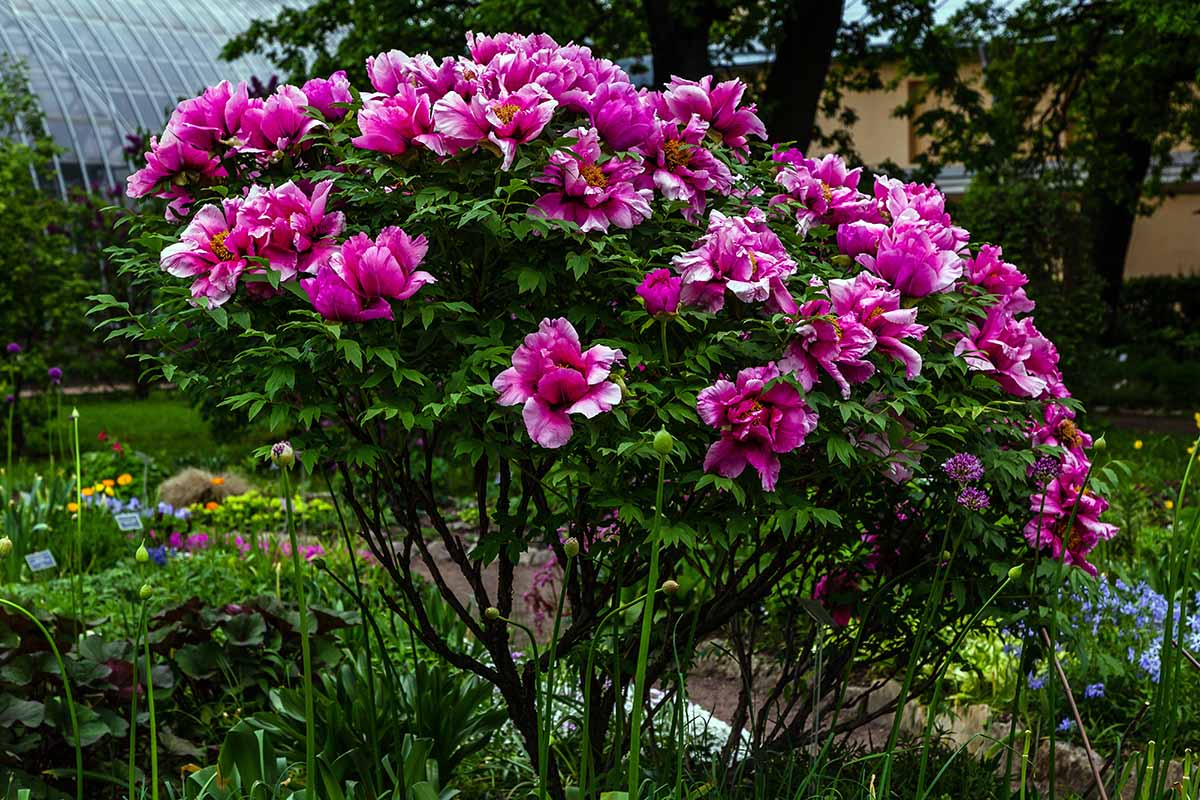
Plants in this group can have either an upright or spreading growth habit. These types are also the most fragrant.
P. x rockii hybrids originated from chilly, arid climates within the Gansu region of China. These plants are distinguished by a purple or maroon flare of color at the center of the flower bloom, near the stamen.
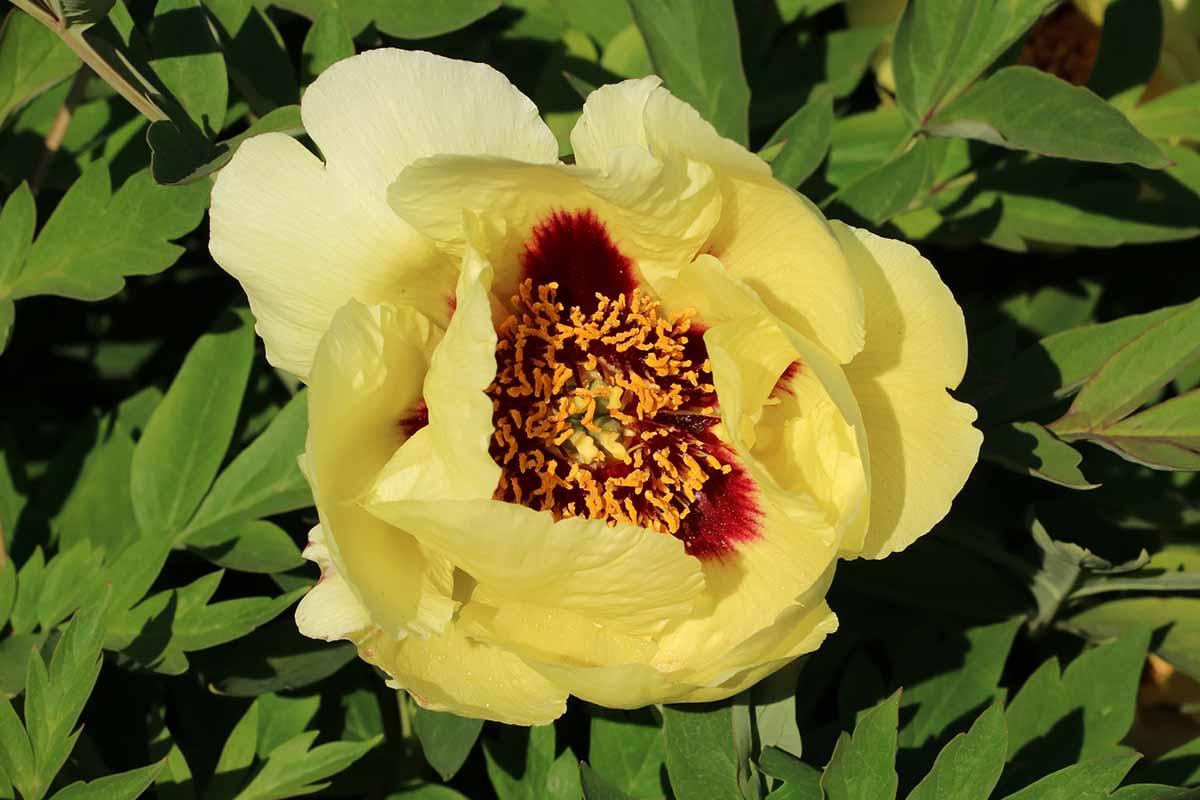
They can take a bit of a beating when it comes to heat, drought, and cold weather. According to the American Peony Society, some cultivars of P. x rockii can withstand heat up to 100°F.
Lutea hybrids are known in horticultural circles as the main group used to create intersectional hybrid peonies.
These have blooms in shades of yellow, pinky copper, red, and bronze. Although their stems die back in the winter, the flowers will bloom on new spring shoots – unlike P. x suffruticosa or P. x rockii.
These shrubs, once established, can live for generations. They can thrive in optimal conditions for up to 100 years.
Tree peonies have a very short bloom time of five to 10 days. The window for flowering will vary based on your specific cultivar and growing zone, but is usually in late spring to early summer, generally from May to early June.
For both P. x suffruticosa and P. x rockii, blooms appear on old wood, or branches grown the previous season, on stems that reach a maximum of six inches in length.
Tree peony flowers can come in a range of forms that generally fall into the following categories:
- Single – one or two layers of petals with a bowl-shaped flower. Stamens are visible.
- Semi-double – two to three layers of petals with a bowl-shaped flower. Stamen is still visible, but partially obstructed by the additional layers of petals.
- Double – multi-layered petals with a bowl-shaped flower. Petals closer to the stamen are more ruffled, obstructing it completely.
There are so many different forms these flowers can take, it can get a bit mind-boggling. You’re in luck – we put together this guide to help you decipher all the different types of peony flowers.
As far as size goes, some tree peony blooms are as large as 12 inches in diameter and others may be as small as two inches in diameter, but generally, most blooms average between seven and 10 inches across.
P. x suffruticosa cultivars are the most fragrant. Scents range from sweet to spicy, and even earthy or dank, like mushrooms. P. x rockii cultivars are commonly sweetly scented, while lutea hybrids are generally known to have citrusy or vanilla-scented flowers.
The blooms of all varieties will attract pollinators like butterflies and bees. However, if you’re trying to cross-pollinate to create new varieties, note that most lutea hybrids don’t produce much pollen and shouldn’t be used for this purpose.
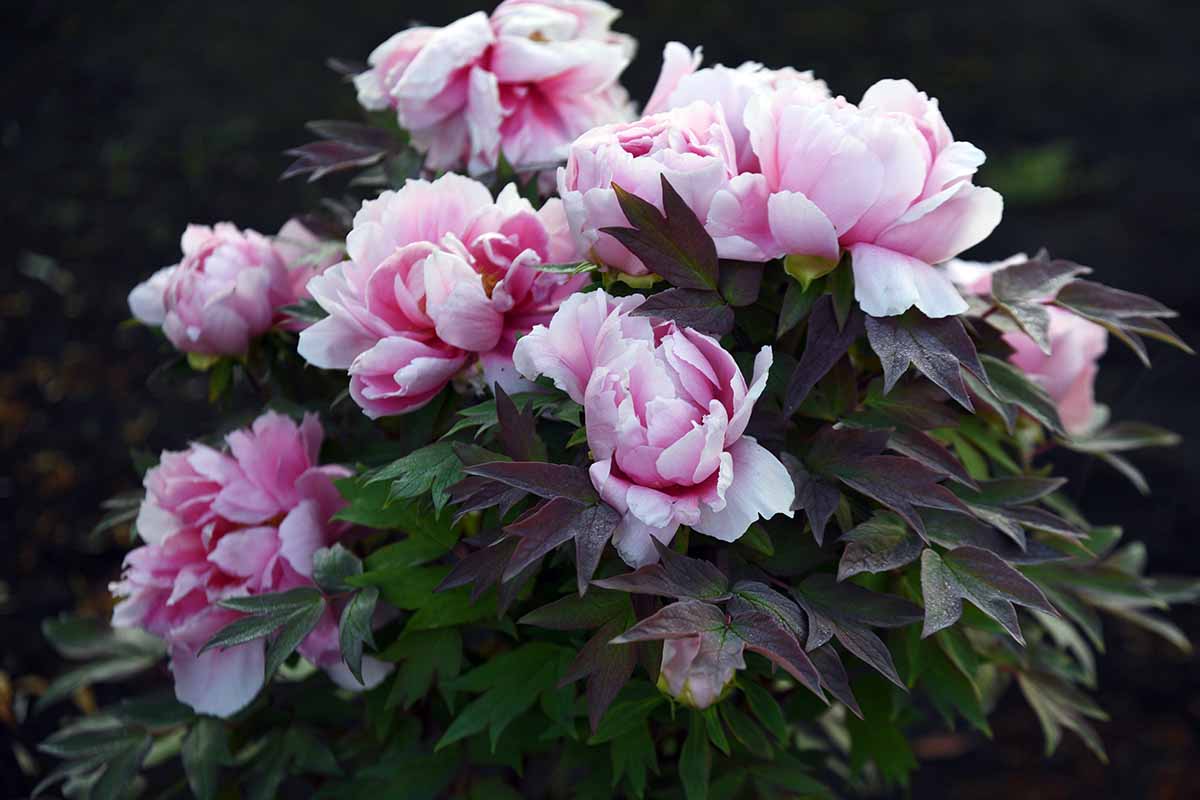
These plants are slow growers, growing between one and six inches a year on average. But the benefit of these types over their herbaceous cousins is that they are much more robust in regards to drought, heat, and cold.
They are deciduous, which means they lose their leaves in the winter. The woody stems allow these plants to survive winters in USDA Hardiness Zones 4 to 8, withstanding temperatures down to -40°F.
Unlike herbaceous types, tree peonies do not require a winter dormancy period to flower the following year. They do, however, require a resting period of several weeks below 40°F.
This lack of a cold dormancy period has allowed tree peonies to grow in a wider range of conditions, which is great news for us gardeners.
Cultivation and History
Over 1,500 years ago in China, several species of woody Paeonia were domesticated and cultivated for their unique chemical components to be used in medicine, which is where their popularity began.
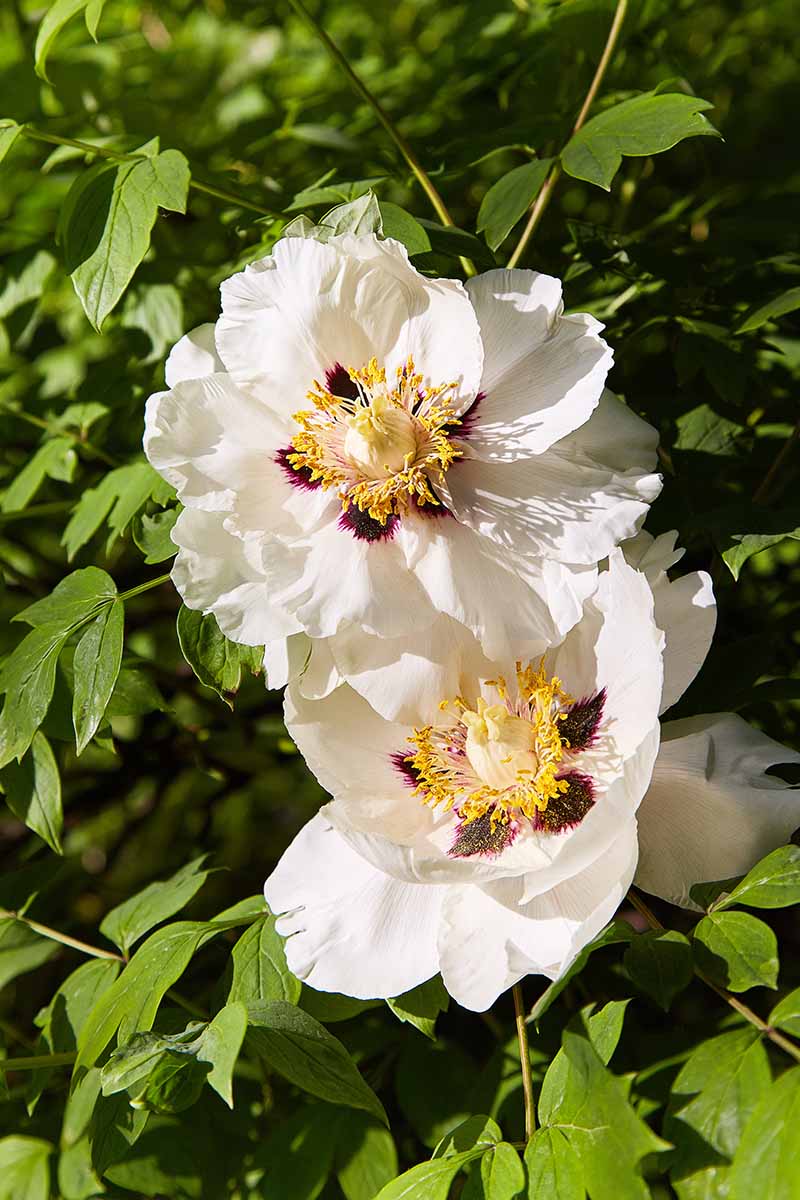
They would later become popular ornamental plants across China during the reign of Empress Wu Zetian of the Tang Dynasty.
In Sandra Knapp’s book “Plant Discoveries: A Botanist’s Voyage Through Plant Exploration” she describes the popularity as more of a craze, similar to the tulip craze in Holland around the 17th century.
The interest in woody peonies would eventually spill across Asia and into Europe. Once in Europe, the plants would be hybridized again to form many of the modern hybrids we know today.
There are currently over 600 different cultivars available commercially, so I hope you’ll find one that you love and enjoy.
Propagation
There are a few ways to start these plants.
It’s generally not a good idea to grow tree peonies from seed, as it can take up to two years for the seed to germinate naturally and up to seven years for the plant to begin to flower.
On top of that, hybrid seeds will not grow true to type, although they may strongly resemble the parent plant.
It’s also difficult to grow tree peonies from cuttings. L. T. Blaney at the Horticulture Department at Oregon State University carried out experiments from 1956 to 1958 on the viability of propagating tree peonies from cuttings.
They based these experiments on reported success in a 1955 issue of the French National Horticultural Magazine, but explained that more testing was needed on this method.
As recently as 2005, researchers from the College of Biological Sciences and Technology in Beijing, and the Forestry University of Beijing, published a paper through Acta Horticulturae Sinica on their success with rooting cuttings for specific varieties of tree peony.
They had the highest success rate of 91 percent with rooting the softwood cuttings of the dwarf P. x suffruticosa ‘Yin Fen Jin Lin’ using vermiculite as the rooting base.
For these reasons, purchasing bare rootstock or grafted rootstock, or propagating via division or branch layering are generally better and more popular options for home gardeners.
From Seed
Commercially available peony seeds are usually dried and have a hard outer seed layer with a soft, dormant embryo inside. For the dried seeds to germinate, water and air must reach the embryo inside the seed.
Dried tree peony seeds can be scarified to speed up the germination process. Using medium grit sandpaper, gently rub the seed coat no more than three times. Without this step, germination would naturally take up to two years.
If you’re able to get hold of freshly harvested seeds, these will germinate on their own and will sprout the following spring.
To harvest seeds from a mature plant, the seed pods should be ready to gather in late summer to early fall. You’ll know it’s time to harvest when the pods become dark brown and start to open up, revealing the seeds inside.
The seeds should be removed carefully from the pods – they will not germinate if they are damaged. The seeds will be tan, brown, or black in color.
To start seeds indoors, place them inside a plastic zip-top bag filled with slightly damp horticultural sand. Then, place this bag onto a heating pad to maintain a temperature of 80°F. Roots should sprout from the seed within 12 weeks.
Fresh, scarified, and pre-sprouted seeds should all be planted in the late fall, around November, as they need a cold stratification period to successfully germinate.
To sow outdoors, plant your seeds approximately two inches deep in their ideal permanent location. Tree peonies grow to be pretty big, so space your seeds about five feet apart, and two and a half feet from the edge of any garden border.
To start your seeds in a pot, use a well-draining, fertile potting mix and a 10- to 12-inch pot with a drainage hole. Plant your seeds two inches apart within the pot.
Allow your seedlings to grow in the pot undisturbed until the following fall. Seedlings should only be separated and planted out after a year of growth. Plant five feet apart, and two and a half feet from your garden border.
Whether growing your seeds directly in the ground or starting in a pot, cover with a three-inch layer of organic mulch to help protect the seeds from woodland critters and prevent the soil from drying out. Avoid mulches containing wood chips or bark, if possible.
Remember, growing tree peonies from seed requires patience!
Grafted Rootstock
If you purchase your plant from a nursery, it’s likely to be the product of grafting. The scion is taken from an adult cultivar and grafted to the rootstock of either an herbaceous or tree peony.
This will decrease the amount of time you’ll need to wait before enjoying flowers, sometimes as early as the following spring.
Dig your planting hole about two feet wide and deep. Choose a location with fertile, well-draining garden soil and mix in some organic compost.
Plant with the graft point buried at least six inches beneath the soil. Many nurseries will tag the appropriate planting depth on the plant’s stem for you.
Planting at the proper depth is important for grafted tree peonies. The goal is for the grafted plant to grow its own root system, eventually rendering the nurse root useless.
If they are planted too shallowly, this will cause the herbaceous rootstock to sprout and try to overtake the tree peony, potentially rejecting the graft.
Water thoroughly and cover the perimeter of the planting area with a two-inch layer of mulch to retain moisture.
For the first two years, water deeply every two weeks in the absence of rain.
Bare Roots
If you’ve purchased your tree peony as a bare root plant, it’s best to plant it in its permanent home instead of nursing it in a pot. Bare root plants are typically available in the fall.
Manually spread the roots apart in your hands prior to planting. Bare roots are usually dense and tangled up when gardeners receive them, and manually detangling will help you avoid air pockets during planting.
Dig your planting hole deep enough that the crown is the only thing exposed aboveground. Make the hole wide enough that you can comfortably spread the roots out flat, without bending them.
Create a small mound of soil at the bottom of the hole for the roots to rest on. This is another way to avoid air pockets directly below the crown of the plant.
Once the roots are placed, begin filling in the planting hole with rich soil. Alternate between water and soil to ensure the roots are completely surrounded.
By Division
It is possible to divide mature tree peonies to create new plants for your garden. Division is best done in the fall on a cool and cloudy day.
However, you’ll want to make sure to only divide those specimens that are good candidates for this method. Shrubs that are at least five years old should have an established root system. In order to survive the division process, the tree peony needs to have adequate growth above ground in addition to a viable root system.
Inspect the growth habit of the tree peony you’re looking to divide. Does the parent plant grow with a single or double stem? Or does the plant have a multi-stemmed growing habit?
Tree peonies with a single or double stem are not good candidates for division.
If you’re growing a grafted plant, the single or double trunk may signal that the root system has yet to grow separately from its nurse rootstock. Once established, it will begin growing with a multi-stemmed habit.
Attempting to divide a single or double stem tree peony will cause a large wound, and increase the chances of disease or pest infestation.
However, if the mature parent plant has multiple stems, that means it has an established root system and you’re good to move forward with division.
You’ll want to carefully dig up your tree peony, making sure you keep the roots intact and undamaged. Grab a shovel, and begin loosening the soil, starting two feet from the base of the plant. Carefully pull your plant out of the ground, exposing the roots.
Once your plant’s roots are exposed, rinse them off with the hose so you can better inspect the root ball. Rinsing the roots will help you clearly see into the root ball, and give you some extra room to detangle the roots with your fingers.
Let your newly excavated shrub rest for three to four hours under a plastic sheet or garbage bag. The roots need to dry out only a little bit. This will make the roots less prone to breakage during division.
Grab a sterile knife and garden shears, and take a look at the roots. If this mature tree peony was originally grafted, you will see old nursery rootstock. Now that your plant is mature and has developed its own root system, the grafted rootstock is no longer needed. Go ahead and cut that away and discard it.
Next, look for a natural division point in the root system that has at least one aboveground stem. Carefully cut the section away from the plant.
You want to do the least amount of damage possible to the roots. If you’re struggling to find a natural division point, grab some of the aboveground growth with both hands and gently twist and pull them in opposite directions.
Are the stems and their roots allowing you to twist without any roots tearing? The twist point is probably a dividing point. Remember not to be too aggressive when you pull and twist the plant apart, and only cut the roots when you’re separating your new plant from the parent.
When you’ve found the division point, cut the plant apart. Depending on the maturity of the original plant, the number of stems, and the amount of healthy roots attached to each stem, you might get multiple new tree peonies from this process.
Each new division should have four to five chunky roots attached to help it become reestablished. These roots should be at least six inches long in order to adequately feed the divided plant.
If you’ve divided some pieces that were a bit too small, and you feel these may lack an adequate amount of roots to thrive, try cutting back up to a third of the top growth. This will keep your tree peony focused on rebuilding its root system.
Plant in your landscape as you would with a new bare root plant as described above.
Remember, tree peonies are slow growers, so it will take a few growing seasons for the divisions to become established and begin to bloom.
From Branch Layering
Layering is the magical process of burying a living stem on a mature plant to develop roots. After this happens, the rooted branch is detached from the parent, and voila! You have a new plant.
In the case of tree peonies, this method works well for creating clones of adult plants and it is a faster process than growing from seed.
However, it works best on varieties that are low-growing with a spreading habit. It’s much more challenging to do this with those that have an upright posture.
If you’d like to give this method a try, the best time to begin is in early spring or early fall. Select a low-growing branch that you can easily bury and secure beneath the soil.
Bury the branch under two inches of soil, then secure it with a few landscape fabric pins.
The roots will sometimes develop over a single season, but some cultivars can take several years to grow sufficient roots.
How to Grow
Tree peonies follow the adage, “first year sleep, second year creep, third year leap,” meaning they put energy into growing roots the first year, shoots the second year, and blooms in the third (or fourth) year.
So once they’re planted, don’t be concerned if you don’t see blooms right away.
You shouldn’t expect flowers from your grafted, divided, or bare root plants until at least the third year. If planted from seed, blooms can take up to seven years to appear.
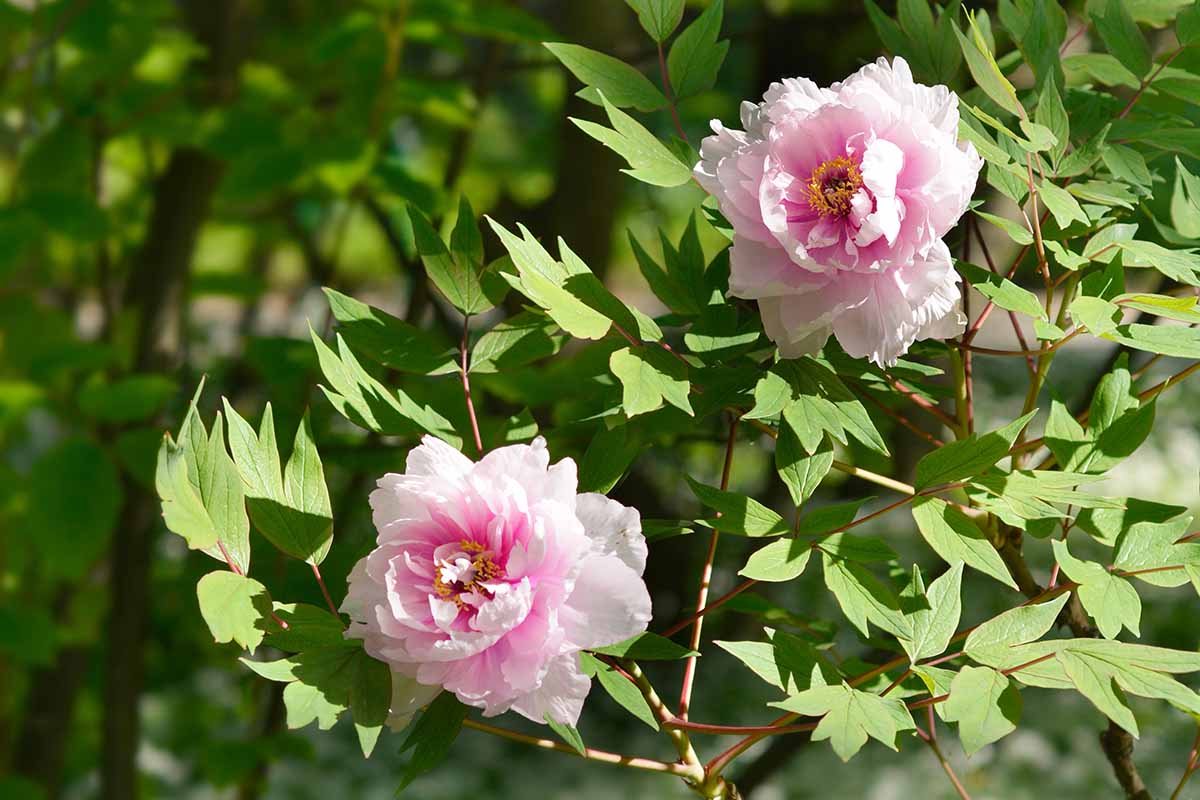
Early to late morning sun, with dappled shade in the afternoon, should work for most cultivars of P. x suffruticosa and lutea hybrids. P. x rockii hybrids can be placed in full sun, but be sure to check your specific cultivar for sun requirements.
As a general rule of thumb, the warmer your climate, the more shade your plant will need, but you should shoot for a minimum of four hours of sunlight a day.
Your plants should reach their mature height and spread within 10 years. Growth habit, size, and spread will be dependent on your selected cultivar.
These plants require fertile, well-draining soil with a pH between 6.5 and 7.5. Having their roots submerged in water will kill these plants, so select a spot either on a slope or in a well-draining area.
If you’re worried about drainage, you can add extra grit to the soil, such as perlite or horticultural sand.
Tree peonies don’t have chilling requirements like herbaceous types. This includes those grafted on herbaceous rootstock. Still, as I mentioned, they do require a resting period of several weeks below 40°F to bloom the following spring.
Unlike herbaceous varieties, tree peonies don’t typically require any staking. However, it’s best to plant them somewhere that is protected from the wind. Otherwise you may need to provide a bit of extra support as they grow.
Tree peonies don’t require much water once established and enjoy deep, infrequent watering. Only water when the top four inches of soil are dry, or every two weeks in the absence of rain. Overwatering is a common point of failure.
Use a rain gauge to measure the amount of precipitation your garden receives, or a moisture meter to check the soil.
These plants will not typically thrive in pots and should always be planted in the ground or in a raised bed if possible.
Once established, tree peonies are incredibly robust.
Growing Tips
- Choose a location with morning sun and dappled afternoon shade.
- Plant in rich, well-draining soil with a pH of 6.5 to 7.5.
- For grafted tree peonies, plant the graft point two to three inches below the soil line.
- Water established plants only when the top four inches of soil are dry, and avoid overwatering.
Pruning and Maintenance
Here’s the good news: tree peonies do not need to be pruned regularly. All you need to do is inspect your plant’s branches annually and remove any dead, weak, or unproductive growth using sterile garden shears.
Both P. x suffruticosa and P. x rockii hybrids bloom on old wood, so make certain that what you’re pruning away will benefit the plant’s health and overall structure.
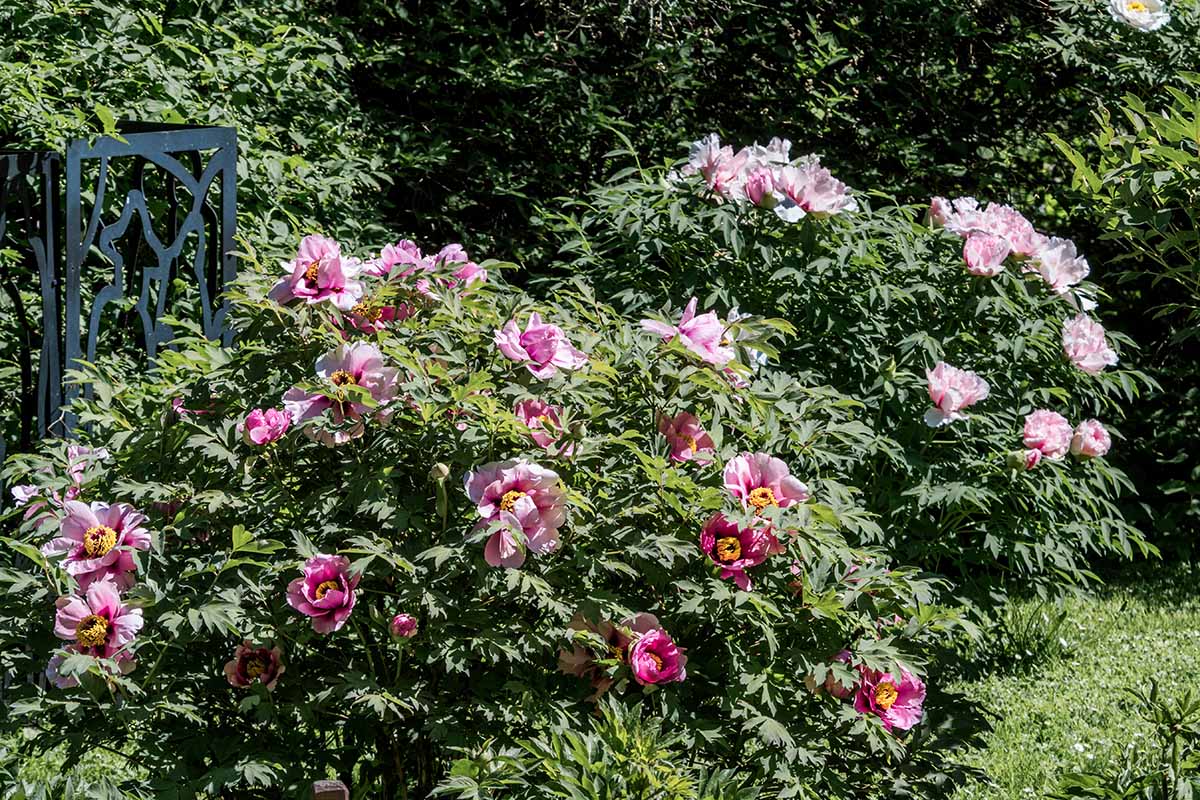
The best time to prune is in early spring, before new growth has emerged. If you wait until after flowering to prune, you may remove too many leaves and limit the plant’s ability to photosynthesize.
Pruning in the fall will cut off developing flower buds that will bloom the following spring.
To create a healthy canopy, remove any branches that are rubbing against each other, growing straight up in the air, or growing towards the ground. Cut back dead stems until you hit healthy growth.
Lutea hybrids die back to the ground each winter and don’t require careful pruning like other types. You can cut back old growth to the ground in winter to clean up the growing area.
Grafted tree peonies are also prone to suckering from their herbaceous rootstock. This usually happens when the peony is planted too shallowly. It’s important to cut the suckers away so that the herbaceous rootstock doesn’t overtake the tree peony.
Herbaceous suckers are a shiny red color, while those of a tree peony are a dull red. If you aren’t sure what you’re looking at, allow the suckers to form leaves. Tree peony leaves are divided, with three lobes on each leaf end. Herbaceous types have ovate leaves that are pointed at the ends.
Spring is the time to cut these suckers away. Just grab a sharp, sterile knife and cut below the soil at the origin point.
If you cut back the suckers and see more emerge, you’ll need to do one of two things:
The easiest option is to mound additional dirt around the plant, up to six inches above the soil line. This should be done after cutting away the herbaceous suckers.
Another option is to dig up and replant your tree peony deeper in the ground. This should be done in the fall, planting the graft point two to three inches beneath the soil line.
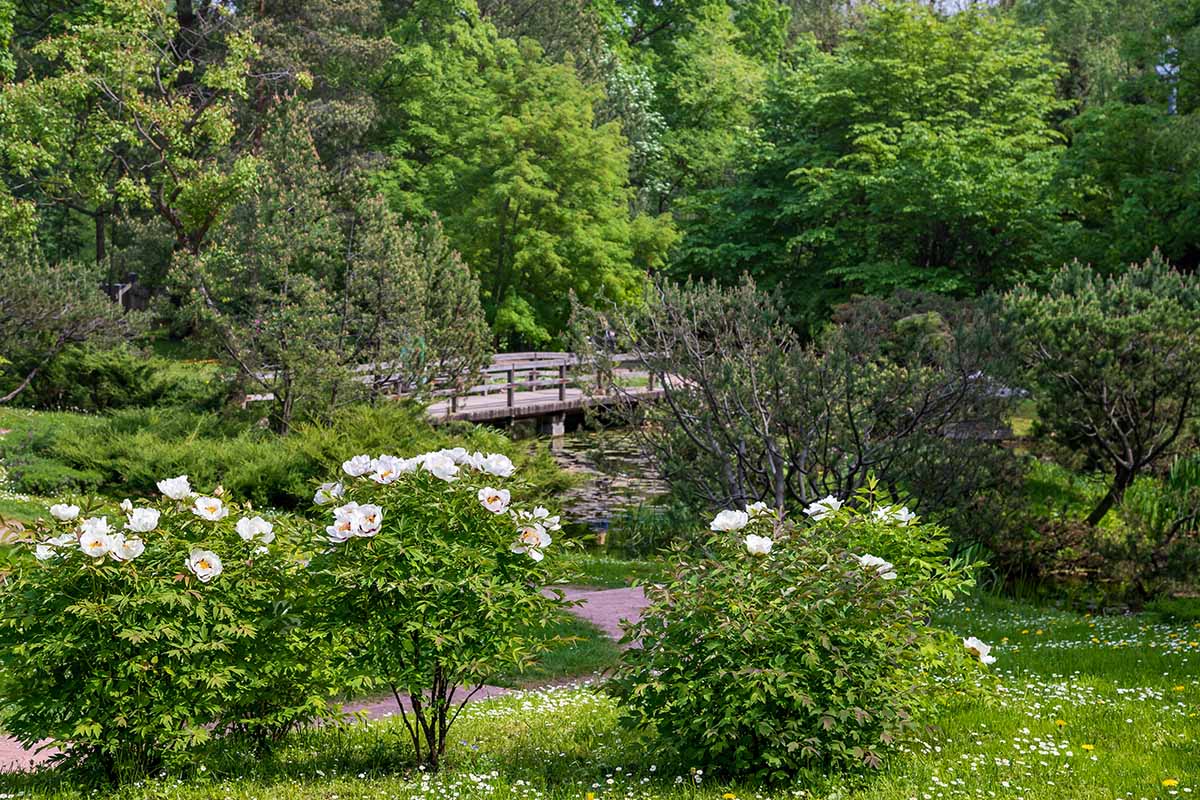
Now, let’s talk about fertilizer.
The time frame to fertilize will vary based on your location, but the moment you’re looking to begin your regimen will be right on the cusp of spring when new leaf growth begins to emerge, around late February to early March.
Before new growth emerges, fertilize with a thin layer of organic compost or well-rotted manure around the perimeter of the planting area. Water thoroughly.
Around eight weeks later, repeat this process to help the shrub thrive during the growing season. And a light application of compost or well-rotted manure six to eight weeks before your first average winter frost date will stimulate root growth to prepare it for winter dormancy.
You will also need to deadhead the blooms when they start to fade, unless you want to allow the flowers to mature in order to collect seeds in the late summer to early fall.
Tree peonies will not be harmed by light frost, but a severe or prolonged early spring freeze will kill flower buds and new shoots for the upcoming season.
If you’re expecting a hard freeze in the early days of spring, cover your plant with frost cloth to protect it from damage. It’s best to not place your covering directly on top of your plant, as it may damage the delicate flower buds.
Cultivars to Select
Now that you have a good understanding of tree peonies and how to grow them, it’s time to choose which varieties you’d like to plant.
Here are a few cultivars that would make wonderful specimens in your landscape.
Godaishu
‘Godaishu,’ also sold as ‘Five Continents,’ is a P. x suffruticosa cultivar with large, pure white flowers that can reach 10 inches across. It grows in Zones 4 to 7.
This cultivar has an upright growth habit and can reach a height of three to five feet tall, and three to four feet wide.
Hana Kisoi
‘Hana Kisoi’ is a Japanese P. x suffruticosa cultivar known for its large, ruffled, cherry-blossom pink flowers.
According to the American Peony Society it’s a heavy bloomer in northern climates in the United States.
Commonly sold under the trade name ‘Floral Rivalry,’ this cultivar has an upright growth habit and grows to be four feet tall and three and a half feet wide. It grows in Zones 4 to 9.
High Noon
‘High Noon’ is an American P. x suffruticosa cultivar, also sold under the name ‘Hai Huang.’ It has lemony yellow flowers with a red flare in the center, surrounding the stamen.
Its fragrance is citrusy, like a lemon, and the flowers are between six and nine inches across.
‘High Noon’ grows to a mature height and spread of five feet, with an upright growth habit. It is hardy in Zones 4 to 7.
Manchurian Promise
This lutea hybrid features a mix of salmon-peach flower petals with a flare of maroon near the stamen. It does not produce pollen, but will produce sparse seeds if hand-pollinated.
It will grow to a height of four feet tall and five feet wide, with an upright growth habit.
Its fragrance is slightly sweet, and can have a longer than average bloom time – up to two weeks in Zone 6. It is hardy in Zones 4 to 9.
Shimadaijin
P. x suffruticosa ‘Shimadaijin,’ aka ‘Island Minister’ is a Japanese cultivar that features dark purple-red, ruffled blooms measuring eight inches across, with a spicy-sweet fragrance.
It’s a vigorous grower with a mature height of four feet and similar spread. Suitable for cultivation in Zones 4 to 9.
If you’d like to add this cultivar to your garden, you can find bare root plants for shipping in the fall available at Burpee.
Snow Lotus on Icy Mountain
‘Snow Lotus on Icy Mountain’ is a Chinese variety that does better with extreme drought-related stress when compared to other cultivars of P. x rockii.
This hybrid group is already notoriously hardy compared to both P. x suffruticosa and lutea hybrids.
Proven to successfully grow and bloom in areas like northern Texas, which is known for record-breaking drought and extreme heat, it performs best in Zones 4 to 9.
It has large, white petals and features the telltale maroon flares that are a feature of all P. x rockii varieties. If you’re worried your climate or environment might be too extreme for a tree peony, give this one a try.
Managing Pests and Disease
I’m happy to say that tree peonies are mostly disease and pest free – but not wholly unproblematic.
Animals
Depending on your location, if something is nibbling on your tree peonies, it’s likely to be a rabbit or a deer.
While it isn’t common to have these animals make a complete meal of your plant’s foliage, they have been found to taste-test young and tender leaves.
If you’re struggling with these animals, your best bet is to construct a physical barrier between them and your plant.
We’ve put together this helpful guide on how to construct a DIY deer fence and you can read more about dealing with rabbits in the garden here.
Nematodes
Nematodes are microscopic roundworms, and they are the main type of pest you’ll encounter with tree peonies.
Foliar Nematodes
There are almost 220 different species of foliar nematodes in the genus Aphelenchoides. The most common species you will encounter in your garden are A. besseyi, A. fragariae, and A. ritzemabosi.
These nematodes typically strike when certain environmental conditions, like moisture and humidity, create an opportunity for infestation.
There is no known pesticide that will completely eradicate these pests from your plants. However, there are solutions to limit the damage. The goal is to knock down nematode populations living on the leaves and in the soil around your plant.
If your tree peony is suffering from an infestation of foliar nematodes, your plant will alert you through the discoloration of the leaves. The mature leaves will begin to turn yellow, purple, or brown, starting at the veins.
These pests spread from leaf to leaf through water, so avoid splashing water on the plant’s foliage, and remove infested leaves as soon as you see signs of damage. From now on, water at the soil line only.
Spray an insecticidal soap onto the foliage of your plant as a knockdown. You can also use the same insecticidal soap as a soil drench, as foliar nematodes will live in the soil for a short amount of time.
Insecticidal soaps are generally broad spectrum and can be used on many types of plants.
You can find insecticidal soap from Bonide available in 12- or 32-ounce bottles at Arbico Organics.
Follow the instructions on the product packaging, or apply weekly until you see your foliage improve.
In the case of a severe infestation, dig up your plant and dispose of it. Don’t plant anything in that location for the next couple of years, if possible, so that the nematodes can die out on their own.
Root Lesion Nematodes
Pratylenchus penetrans root lesion nematodes may cause lesions on the roots of tree peonies. When they infest the roots, they suck out important nutrients, which can cause nutritional deficiencies and stress to your plant.
You’ll know your plants are infested with these nematodes if you begin to notice yellowing leaves and stunted plant growth, in addition to a lack of flowers.
The best way to combat these pests is with a few treatments of neem oil concentrate, mixed in with your current watering regimen.
A high quality, specially formulated neem oil concentrate like Rango 3-in-1 from Arbico Organics can be used to combat these pests. Rango 3-in-1 is formulated with high-quality cold-pressed neem oil.
Tree peonies like heavy but infrequent watering in the absence of rain. When you water your shrub, add the proper amount of neem oil based on the ratios listed on the product packaging.
Disease
Tree peonies are hardy and shouldn’t struggle with disease. However, there are a few you might have to deal with, so let’s review.
Canker
Canker is common and widespread on a number of woody plants.
Actually the symptom of another type of infectious disease affecting your plant, it could be caused by an infection in the bark. Injuries can become infected by either bacteria or fungi.
Cankers will often kill off entire branches, or serve to weaken your tree peony considerably until the canker is removed.
You’ll know you’re dealing with canker if you see sunken and discolored lesions. These will appear either on stems or on the trunk of your plant.
Common signs of a bacterial or fungal infection are foliar leaf spots, misshapen flowers and buds, and irregular growth.
The most common types of fungi to infect tree peony cankers are Gloeosporium and Colletotrichum species, which are both known to cause anthracnose in tree peonies.
To combat cankers, you’ll want to remove all infected plant parts and dispose of them in your trash or firepit.
Make sure your plant receives adequate airflow, and remove any dead leaves or decomposing plant debris from the surrounding area that might be carrying infectious fungal spores looking for a new host.
Finish off with a treatment of a broad spectrum fungicide, like Arber Biofungicide from Arbico Organics.
Gray Mold
Botrytis cinerea is a pathogen that will cause hollow stems, leaf death, and rotting blooms on your tree peonies. Gray mold can spread to other plants within your landscape, so it’s essential to deal with an infection as soon as possible.
If you have consistently had issues with gray mold in your garden in the past, consider planting a resistant variety of tree peony.
According to a 2019 study published in HortScience, researchers were looking for B. cinerea-resistant P. x suffruticosa cultivars.
Fifteen different cultivars were selected and tested for resistance to B. cinerea. ‘Five Continents,’ ‘Sheng Dai,’ and ‘Golden Island’ showed good resistance to gray mold as part of this study. ‘Two Qiaos’ and ‘Hai Huang’ were shown to be moderately resistant.
The next best way to fight gray mold is to keep a tidy area around your plant after deadheading, and be sure to rake away the leaves that drop in the fall. This removes places for spores to overwinter.
Using a broad-spectrum fungicide will also help keep gray mold at bay.
Consider this copper-based fungicide by Bonide available from Arbico Organics.
Peony Leaf Spot
This disease is caused by the fungus Cladosporium paeoniae. This pathogen strikes in warm, humid weather and will turn your peony’s leaves a spotty, purplish-brown. If it’s not managed, leaf growth will become distorted, so action needs to be swift.
First, let’s talk about prevention. Keeping the area around your tree peony clean and sanitary will help to protect your plants. Rake away fallen leaves, and make sure your plant has proper airflow.
Next, if you’re dealing with an infection, remove all infected plant parts and put them in your trash or burn pile. Use a copper-based fungicide to combat infection.
Powdery Mildew
Powdery mildew is a type of fungal disease that can affect a wide range of plants. There are many different species of fungi that cause powdery mildew, but the symptoms are usually the same.
You’ll know you’re dealing with this ailment if your plant’s leaves become covered in what looks like a white residue. Infection will occur in the summer months when the air is humid and warm.
Luckily, powdery mildew is not fatal to tree peonies. If your plants are experiencing an infection, it’s unlikely that you will be able to completely rid your plant of this fungus until the leaves drop during dormancy.
You can, however, use preventative remedies during the summer to keep the fungi at bay. Routinely spraying your shrub’s foliage with neem oil, or a homemade milk spray, are great preventative solutions.
A milk spray of 30 percent milk and 70 percent water has been proven to be successful at fighting powdery mildew with all kinds of outdoor plants susceptible to this fungus. Spray during the day.
Learn more about powdery mildew in our guide.
Root or Stem Rot
Root or stem rot is caused by the water mold Phytophthora cactorum. Root or stem rot is a common reason for plant death with tree peonies, due to overwatering or being planted in soil that doesn’t drain well enough.
There are no guarantees that your peony will survive the stress of root rot, so it’s important to get the planting site correct the first time. When planting, the soil needs to be organically rich and well draining. Amend your garden soil with perlite, horticultural sand, or vermiculite to improve drainage.
If your plant is currently experiencing root rot you’ll see lesions developing along the stems, causing some stems to fall over. The crown will be wet to the touch.
You may unfortunately be out of options to save your tree peony. Overwatering your plant is a surefire way to kill it, and your best bet might just be to remove it and start over.
Best Uses
Woody peonies planted in spring garden beds will offer a warm welcome every year. And after their blooms have faded, the lush leaves provide an excellent backdrop for other specimen plants you may be growing nearby.
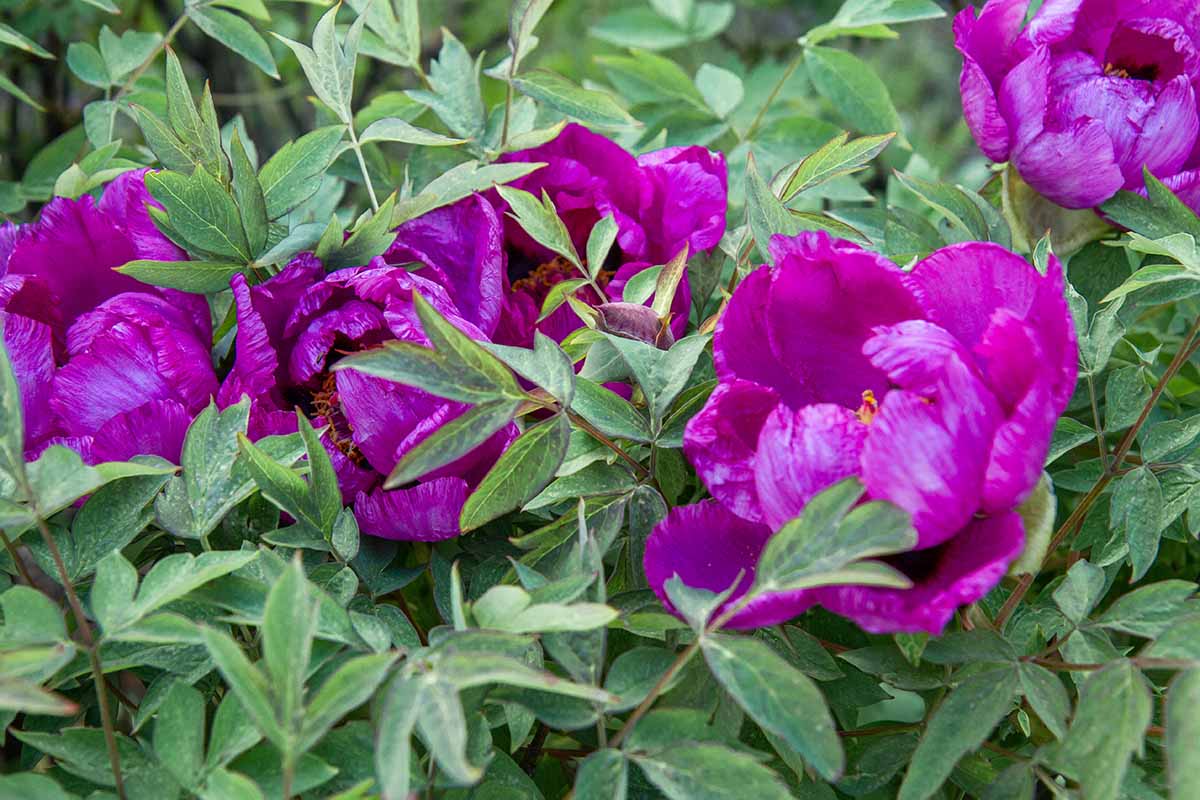
The spring blooms are a cheery addition to cottage, Japanese, or Chinese gardens. Due to the wide range of flower colors and forms available, you might consider using your tree peony as a standalone specimen plant.
Some blooms can be the size of a dinner plate, and they make beautiful floral displays.
Tree peonies also make excellent additions to gardens that need a boost of winter interest. When the leaves shed in the winter, the stems can provide structural interest until new growth sprouts in the spring.
Quick Reference Growing Guide
| Plant Type: | Woody flowering perennial | Flower / Foliage Color: | Magenta, maroon, pink, red, yellow, white, bicolored/green |
| Cultivated In: | China, Europe, Japan, US | Tolerance: | Drought, heat, light frost |
| Hardiness (USDA Zone): | 4-9 | Soil Type: | Organically rich |
| Bloom Time: | Spring to early summer | Soil pH: | 6.5-7.5 |
| Exposure: | Full sun | Soil Drainage: | Well-draining |
| Spacing: | 5 feet | Attracts: | Bees, butterflies |
| Planting Depth: | 2 inches (seed), 6 inches below soil surface (graft) | Companion Planting: | Bearded iris, crocus, miniature daffodil, tulip |
| Height: | 36-84 inches | Uses: | Beds, borders, Chinese garden, cottage garden, Japanese garden, pollinator garden, specimen plant |
| Spread: | 36-60 inches | Order: | Saxifragales |
| Time to Maturity: | 10 years | Family: | Paeoniaceae |
| Water Needs: | Low | Genus: | Paeonia |
| Maintenance | Medium | Species: | Delavayi, rockii, suffruticosa hybrids |
| Common Pests: | Deer, foliar nematodes, rabbits, root lesion nematodes | Common Diseases: | Anthracnose, canker, gray mold, peony leaf spot, powdery mildew, root or stem rot |
A True Spring Specimen
Once established, woody-stemmed peonies, known as tree peonies, are incredibly hardy and long-lived. If properly cared for and placed in ideal growing conditions, this plant can last for generations.
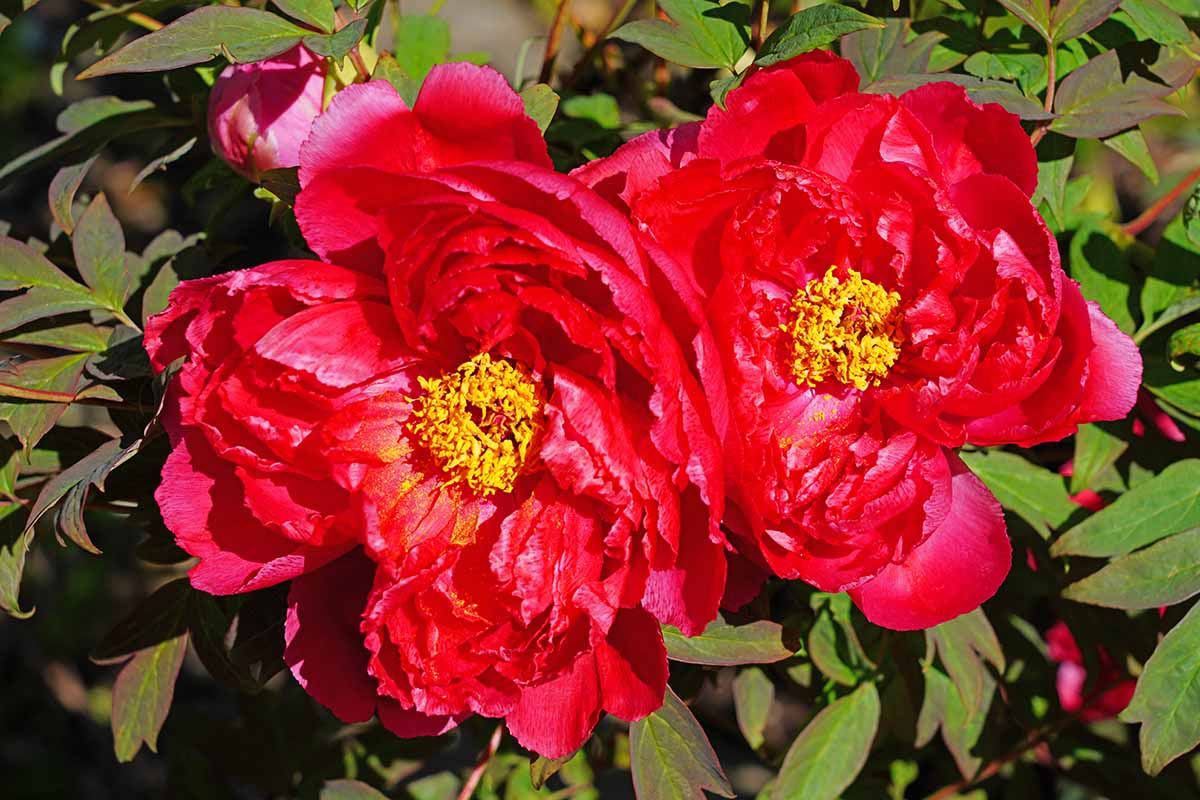
Are you currently growing tree peonies in your landscape? I’d love to hear more about your experience. Please share a picture when it’s in bloom and let us know what type you’re growing in the comments below!
If you enjoy peonies and want to learn more, be sure to check out some of these other articles next:
